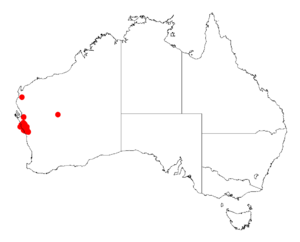Acacia oldfieldii facts for kids
Quick facts for kids Acacia oldfieldii |
|
|---|---|
| Scientific classification | |
| Genus: |
Acacia
|
| Species: |
oldfieldii
|
 |
|
| Occurrence data from AVH | |
Acacia oldfieldii is a type of shrub that belongs to the large Acacia plant family. It is special because it only grows in western Australia, meaning it is an endemic species there.
About the Plant
This bushy shrub usually grows to be about 1.2 to 5 metres (4 to 16 ft) tall. Its branches are smooth, meaning they have no hairs. This is called glabrous. When new parts of the plant grow, they often have a shiny, golden-yellow color.
Like most Acacia plants, Acacia oldfieldii has phyllodes instead of true leaves. Phyllodes are flattened leaf stalks that look and act like leaves. The phyllodes of this plant are always green and can be straight or slightly curved. They are thin but tough, smooth, and have yellow edges. They are about 7 to 16.5 cm (2.8 to 6.5 in) long and 3 to 5 mm (0.12 to 0.20 in) wide. They have many thin lines (nerves) running along them and a tip that can be straight or slightly curved backwards.
Flowers and Seed Pods
Acacia oldfieldii flowers from June to September. Its flowers grow in simple groups called inflorescences. These are found in pairs where the leaf stalk meets the stem (this spot is called the axil). The flower spikes are shaped like cylinders, about 30 to 45 mm (1.2 to 1.8 in) long and 4 to 5 mm (0.16 to 0.20 in) wide. They are loosely packed with bright golden flowers.
After the plant flowers, thin, smooth seed pods start to form. These pods are long and narrow, and they are slightly raised over each seed, with narrow parts between the seeds. The pods can grow up to 10 cm (3.9 in) long and are 2 to 4 mm (0.079 to 0.157 in) wide. Inside, the seeds are arranged lengthwise. The seeds are shiny black, oval-shaped, and about 3.5 to 4 mm (0.14 to 0.16 in) long. Each seed has a small, cone-shaped attachment at one end called an aril.
How it was Named
The first sample of Acacia oldfieldii that scientists studied was collected by Augustus Frederick Oldfield. He found it along the Murchison River. Later, in 1863, a botanist named Ferdinand von Mueller officially described the plant. He did this in his work called Fragmenta Phytographiae Australiae.
The plant's scientific name, oldfieldii, was chosen to honor Augustus Frederick Oldfield, who first collected the sample. For a short time in 2003, the plant was reclassified as Racosperma oldfieldii, but it was moved back to the Acacia group in 2006.
Where it Grows
Acacia oldfieldii is found naturally in the Mid West region of Western Australia. It grows from around Northampton in the north down to Geraldton in the south.
You can often find this plant on small hills and rocky plains. It grows well in sandy and clay soils, and also on sandstone. It is common in coastal areas, from around Eradu in the southeast up to Kalbarri National Park in the north. Here, it grows in soils over gravel, sandstone, ironstone, and limestone. It is often part of sandplain shrubland communities, growing alongside other plants like Calothamnus and Melaleuca species.

